Best trampoline exercises have become my go-to choice for improving my cardiovascular health, enhancing endurance, and finding a fun way to relieve stress and tension. The best part is that I can conveniently enjoy these workouts right at home.
Not only do they offer a convenient option, but trampoline exercises also provide a wide range of benefits. I’ve noticed significant improvements in my balance, coordination, and motor skills since incorporating them into my routine.
Plus, they target various muscle groups including my back, core, legs, arms, neck, and glutes. What’s even more impressive is that research suggests trampolining can positively impact bone health by promoting better bone density and strength.
Best Trampoline Exercises: Best trampoline exercises for enhanced cardiovascular fitness, improved balance, and targeted muscle development. Elevate your workout routine with these fun and effective trampoline workouts.
Best Trampoline Exercises for Weight Loss
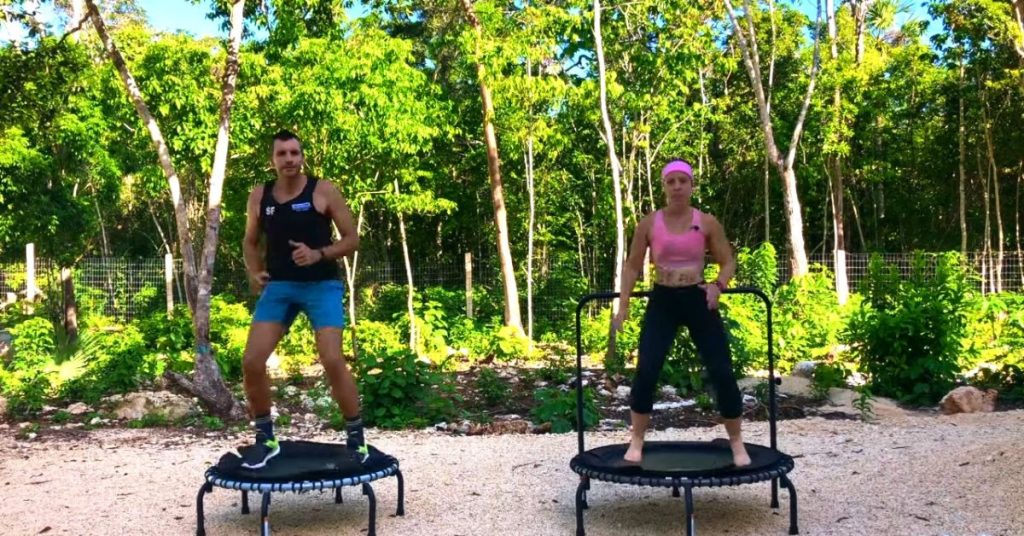
If you want to add trampolining to your regular fitness routine and lose weight, here are some simple trampoline exercises to help you get started. These exercises are easy to do and can be a fun way to shed those extra pounds.
Master the Tuck Jump:
To perform a tuck jump on a trampoline, start by bouncing a few times to build up momentum. As you bounce higher, bring your knees up toward your chest at the peak of the jump. You can also try alternating knees for variation.
Remember, the higher you bounce, the more energy your body will use and the more calories you’ll burn. For an extra challenge and to work your core muscles, tuck your knees under your body while jumping, which will also help improve your stability and strength.
Master the Straight Jump:
In the straight jump, you’ll start by bending your arms and knees slightly as you bounce up and down on the trampoline. This simple movement has multiple benefits, including burning calories, loosening joints and ligaments, and warming up your body for more intense exercises.
Additionally, lightly bouncing on the spot can be a great way to cool down after your workout. For a fitness challenge, try bouncing on the spot for 2 minutes and count how many times you can go up and down. After a month, check your progress to see how your speed and agility have improved!
Master the Pike Jump:
Engage your core muscles with pike jumps, a trampoline exercise that involves keeping your legs straight and reaching for your toes in mid-air. Jump from side to side or even front to back with your feet together, landing and taking off simultaneously.
This exercise is great for toning and conditioning your core stomach muscles. Aim to complete as many sets as you can in 30-60 seconds, taking short breaks in between before starting again. It’s a challenging yet rewarding workout for your core strength.
Running Man Plyometrics:
Running man plays on a trampoline is like jogging but with much higher and quicker knee lifts. This exercise is especially beneficial for those with joint pain, as it provides a non-impact surface to work on.
You can enjoy the intensity of running without the impact on your joints. Additionally, running man plyos can function as high-intensity interval training (HIIT).
To incorporate HIIT into your workout, alternate between casually jogging for 15 seconds and sprinting with high knees for the next 15 seconds, repeating this one-minute cycle with a 30-second rest in between.
Knee-Bounce:
The hands and knees jump is a fantastic exercise for toning multiple parts of your body during a trampoline cardio workout. Start by bouncing up with a flat back and then land on all fours, resembling a “cat” position.
Keep your hands and knees strong when you land, and remember to stretch your arms up as you jump before landing. Begin with a slow pace to focus on maintaining proper posture during the hands and knees jump.
As you progress, gradually increase the length of each interval to create a high-intensity cardiovascular workout.
Master the Split Pike Jump:
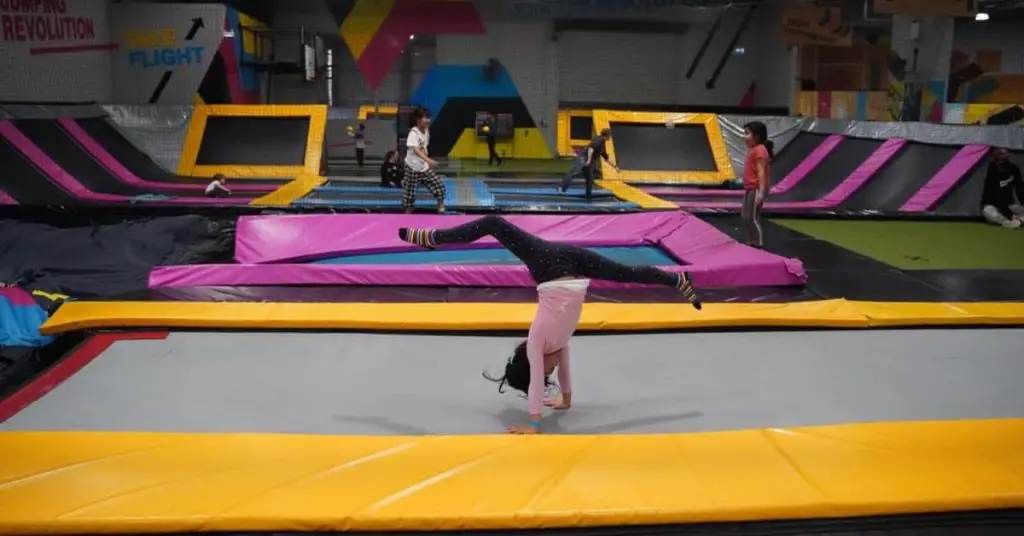
The split pike bounce, resembling a star jump, is an enjoyable exercise that has been popular in gymnastics and aerobics training. However, it’s even more fun when performed on a trampoline!
Incorporating split pike jumps into your trampoline cardio workout will help improve cardiovascular fitness, endurance, and coordination. Aim to do sets of 30-60 seconds with short breaks in between. Begin with your feet together and arms by your side.
Jump up high, spreading your legs apart and raising your arms to create the star position at the peak of each bounce. When landing, return to the same starting position. Enjoy the benefits and excitement of split pike jumps on your trampoline!
Workout with Butt Kicker Jumps:
To perform butt kicker jumps on a trampoline, start by standing in place and jogging lightly. Then, bend one knee at a time and kick your foot back toward your butt. Alternate between legs for each kick.
For an added challenge, you can bounce up slightly and bend both knees simultaneously, bringing both feet towards your butt. Keep this motion going for 1 to 3 minutes.
Butt kicker jumps are a great way to engage your leg muscles and get your heart rate up during your trampoline workout.
Strength with Single Leg Hops:
Single-leg hops on a trampoline involve hopping twice on each leg while maintaining balance. As you hop, alternate raising your arms at your sides to help with balance.
This exercise targets multiple muscle groups including the hamstrings, glutes, and core, while also improving balance and agility. If you find it too easy, you can progress by raising alternating arms to the sky as you hop on one leg.
This increases the intensity, raising your heart rate and providing additional cardiovascular benefits. Enjoy the full-body workout and improved balance that single-leg hops offer during your trampoline exercise routine.
Weaves and Bobs:
To perform bobs and weaves on a mini trampoline, start by bending down into a squat position. Then, push back up using one leg and repeat the squatting motion. Alternate between pushing up with each leg.
Doing this exercise on a mini trampoline adds a challenge to your balance and stabilization due to the proprioceptively-rich environment it provides. Proprioception involves sensing your body’s position without looking, and it not only benefits your body but also challenges your brain.
Bobs and weaves engage both the upper and lower body, improving hand-eye coordination and reflexes. Enjoy the physical and mental benefits of this exercise during your trampoline workout.
The Lunges:
If you’re feeling tired of regular lunges, give trampoline lunges a try. Lunges are a classic way to target your legs and glutes, but they can become monotonous.
To add a new twist, perform lunges on a trampoline by placing one foot on the trampoline netting and the other foot on the ground.
This variation adds an extra challenge because the trampoline provides additional momentum, requiring your legs and glutes to work harder to stabilize your entire body.
Trampoline lunges bring a fresh and engaging element to your workout routine, allowing you to reap the benefits of this exercise in a new and exciting way.
Trampoline Exercise: Scissor Switch
Scissor switches are a great way to target your abs, inner thighs, and glutes. This exercise challenges these muscle groups by requiring you to keep your legs close together and maintain an even body alignment between both feet, according to Giampaolo.
Here’s how to do it: Start with a narrow stance on the trampoline, placing one foot in front of your body and the other foot positioned behind you. As you bounce, switch the position of your feet by moving the back foot forward and the front foot to the back.
Land on the trampoline with equal weight on both feet. Keep bouncing while alternating the movement of each leg. To add an extra challenge, pump your arms in the opposite direction of your legs.
Aim for 20-30 repetitions or continue the movement for 30 seconds to one minute. Scissor switches are a fantastic way to work your core and lower body, providing a dynamic and effective trampoline exercise.
Mini Trampoline Workouts:
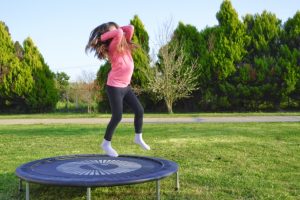
Let’s explore a few exercises you can try on a mini trampoline. Check out the accompanying video to see these exercises in action and get a better understanding of how to perform them.
Pelvic Floor with Jumping Exercises:
Strengthen Your Pelvic Floor and Thigh Muscles with Mini Trampoline Jumps:
To perform this exercise, follow these steps:
- Place a small exercise ball or block between your knees.
- Start by jumping up and down on the mini trampoline, keeping a slow and gentle pace.
- Pay attention to engaging the muscles in your pelvic area throughout the exercise.
- Squeeze the ball by activating your inner thigh muscles.
- Continue jumping for 1 to 3 minutes, focusing on maintaining proper form and engaging the targeted muscles.
By incorporating this exercise into your routine, you can effectively target and strengthen your pelvic floor and thigh muscles. Remember to start slowly and gradually increase the duration as you feel more comfortable and confident.
The Jack Jump:
Energize Your Body with Jumping Jacks: Mini Trampoline Exercise
To perform jumping jacks on a mini trampoline, follow these steps:
- Begin by standing with your feet together and your arms resting alongside your body.
- As you jump, simultaneously raise your arms overhead while jumping your feet apart.
- Return to the starting position by jumping your feet back together and lowering your arms.
- Continue this movement for 1 to 3 minutes, focusing on maintaining a comfortable pace.
When doing jumping jacks on a mini trampoline, you can slightly lean your torso forward for better balance. Alternatively, you can modify the exercise by raising your arms to shoulder height instead of lifting them overhead.
Jumping jacks are a fantastic way to activate your body and get your heart pumping, making them an excellent addition to your mini trampoline workout.
Related article:7 Best Mini Trampoline
Get Fit and Have Fun with a Trampoline Workout Routine
Grab a stopwatch and get ready for an intense core workout on your Vuly trampoline. This routine consists of one-minute rounds of targeted exercises, designed to be completed over a 10-minute period for maximum effectiveness.
Get ready to burn those calories and strengthen your core muscles with this fun and challenging trampoline workout!
Tuck Bounces:
Complete Three Sets of Ten Repetitions!
- Begin by bouncing in the center of the trampoline and bring your knees up towards your chest as you jump upwards.
- As you reach the peak of your jump, release your hands and land back on the trampoline in a standing position.
- Tuck jumps are a dynamic and challenging exercise that effectively strengthens your core muscles. By engaging your midsection, you’re utilizing the power of your body’s strongest muscles.
Trampoline Plank Challenge:
Complete a 30-Second Trampoline Plank Hold!
- Start by lying on your stomach on the trampoline mat.
- Prop yourself up on your forearms and the tips of your toes, creating a bridge-like position.
- Maintain this position for at least 30 seconds before relaxing.
- The soft surface of the trampoline mat adds an extra challenge to your core muscles, requiring more balance and engaging your core even more than a regular plank exercise on solid ground. Get ready to feel the burn and strengthen your core with this trampoline plank challenge!
Trampoline Bouncing Warm-Up:
Complete Four Sets of Ten Repetitions!
- Before starting your trampoline workout, it’s crucial to warm up your body.
- Performing simple bounces on the trampoline is an excellent way to get acquainted with the surface, improve your balance, and prepare your muscles for the workout. This warm-up step is essential in preventing injuries.
- By warming up, your heart rate increases, allowing your body to burn more calories and achieve optimal results from your workout. Get ready to get your body in motion and maximize your trampoline workout!
Trampoline Elevated Crunches:
Complete Three Sets of Ten Repetitions!
- Lie down on the trampoline mat with your back flat on the surface.
- Lift your legs up into the air and gently rest them against the trampoline net in front of you.
- Hold this position for a moment, then slowly lower your legs back down to the starting position.
- Performing crunches with elevated legs on the trampoline adds extra intensity to the exercise, and the soft surface of the mat and the safety enclosure reduce the risk of injury.
- Get ready to engage your core and strengthen your abdominal muscles with trampoline-elevated crunches!
Utilize Your Trampoline Frame for Effective Exercises:
Did you know that you can make use of the frame on your Vuly trampoline for effective home workouts? The sturdy and stable beam of the trampoline frame can serve as a starting point for various beneficial exercises.
Here are some exercises that help strengthen and tone your body by utilizing the frame of your trampoline. However, it’s important to remember to never touch the trampoline frame while someone is bouncing to ensure safety.
Twist and Tone Your Core:
Revitalize Your Core with Torso Twists
This exercise is great for strengthening your core muscles, which include your abs and back. Building a strong core improves balance, and posture, and can help alleviate back pain caused by weak muscles.
To perform torso twists, assume a “leaning push-up” position with your hands gripping the trampoline frame and your legs extended behind you. Twist your torso to the right side, starting with your right arm.
Slowly raise your right arm straight up toward the sky. Return to the starting position, gripping the trampoline frame, and then switch to the left arm. Alternate between the two arms for the desired number of repetitions.
Strength with Arm Dips:
This workout is an amazing upper-body routine. It begins with a small dip and gradually increases the depth as you go along.
- Put both hands flat on the top of the trampoline frame, making sure your arms are slightly wider than your shoulders.
- Jump up, keeping your knees bent and toes just above the ground. Use your extended arms to support your body weight, as if you’re getting ready to climb onto the trampoline.
- Gently bend your arms to perform a small dip with your body, and then straighten them to go back to your starting position.
Incline Push-Ups:
This exercise replicates the classic push-up movement, helping you achieve toned and defined arms without the added strain of being on a flat surface.
- Position both hands slightly wider than shoulder-width apart on the frame of your Vuly trampoline, holding onto the sides for stability.
- Step your feet backward, keeping your legs together. Balance on your toes with your legs fully extended.
- Lower your upper body toward the trampoline frame by bending your arms, just like in a regular push-up. Then, extend your arms back to the starting position. Keep your core tight and engaged throughout the exercise!
Cross-Knee Crunches:
Here’s another fantastic core exercise that targets your glutes as well. To add an extra calorie burn, you can increase the speed!
- Assume the position of a leaning push-up, with both hands on the ground and your body forming a straight line.
- Bring one knee up diagonally in front of your torso, performing a knee kick. Twist your torso slightly as you do this. Then, touch your toe back down to the ground.
- Complete the desired number of repetitions, and then switch sides to work the other leg.
Trampoline Boxing Workout
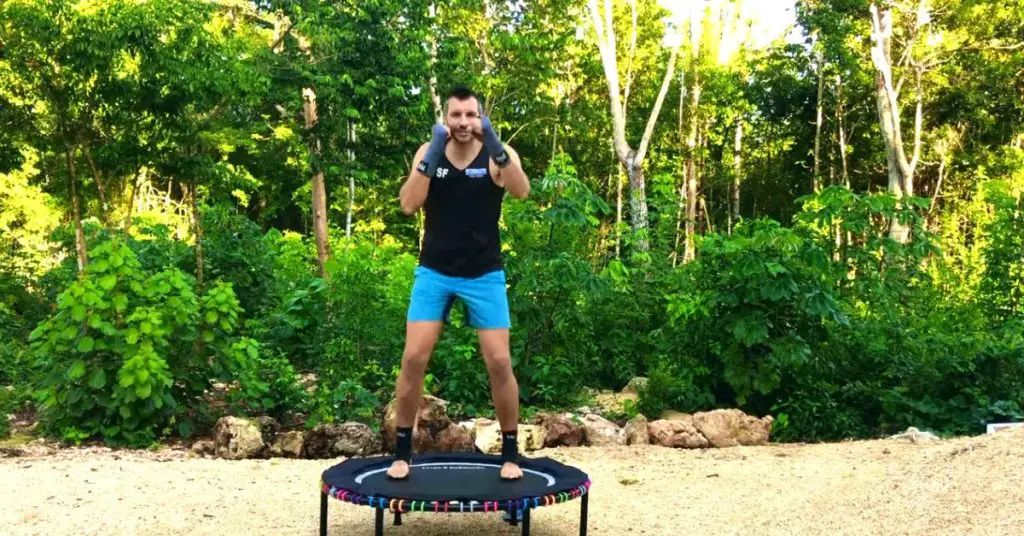
There’s a good reason why boxing skills are frequently incorporated into fitness boot camps and intense workouts – it’s often hailed as one of the most physically demanding sports out there!
Boxing is a dynamic workout that engages all the major muscle groups in your body. Not only does it elevate your heart rate, leading to calorie burn, but it also strengthens and tones your muscles while enhancing your balance and coordination.
Moreover, boxing offers a wide range of techniques and movements, making it an engaging workout throughout the session, unlike, for example, running on a treadmill for long periods of time.
Solo Trampoline Boxing Workout:
Don’t have gloves or a boxing partner? No worries! This straightforward boxing workout combines classic moves with calorie-burning bouncing.
Here’s how it goes: Do each exercise for one minute, then take a 30-second break to bounce and cool down before moving on to the next exercise.
Exercise 1: Jabs
- Stand with your legs slightly apart for balance and your knees slightly bent.
- Hold your fists up in front of your chin.
- Tighten your core muscles and throw quick punches, alternating between your left and right arms.
- Give it your all and avoid twisting your body too much.
- After one minute, take a 30-second break to bounce.
Exercise 2: Hooks
- Get into the same boxing stance as before.
- Swing each arm from the side of your body, imagining you’re hitting a boxing bag.
- Alternate between left and right hooks.
- Keep the fist you’re not using up near your face for balance.
- After one minute, take a 30-second break to bounce.
Exercise 3: Uppercuts
- Picture someone holding pads at eye level, facing the ground.
- Throw punches upward, as if you’re trying to hit those pads.
- Keep your stomach tight and your feet firmly on the ground.
- After one minute, take a 30-second break to bounce.
Exercise 4: Dips
- Stand with your feet apart and facing forward.
- Dip from side to side while holding your fists close to your chest.
- This mimics a boxer’s movement to avoid getting hit.
- Get low and really engage your core.
- After one minute, take a 30-second break to bounce.
- That’s the routine! Enjoy the workout!
Boxing and Bouncing:
Adding a boxing routine to your trampoline workout not only adds excitement but also creates a high-intensity workout that burns fat and gets your heart pumping!
By combining boxing movements with bouncing on a flexible mat, you activate your core muscles, increase your strength, and improve your balance. Both your legs and arms are constantly working throughout the routine.
Yoga Practice with Trampoline
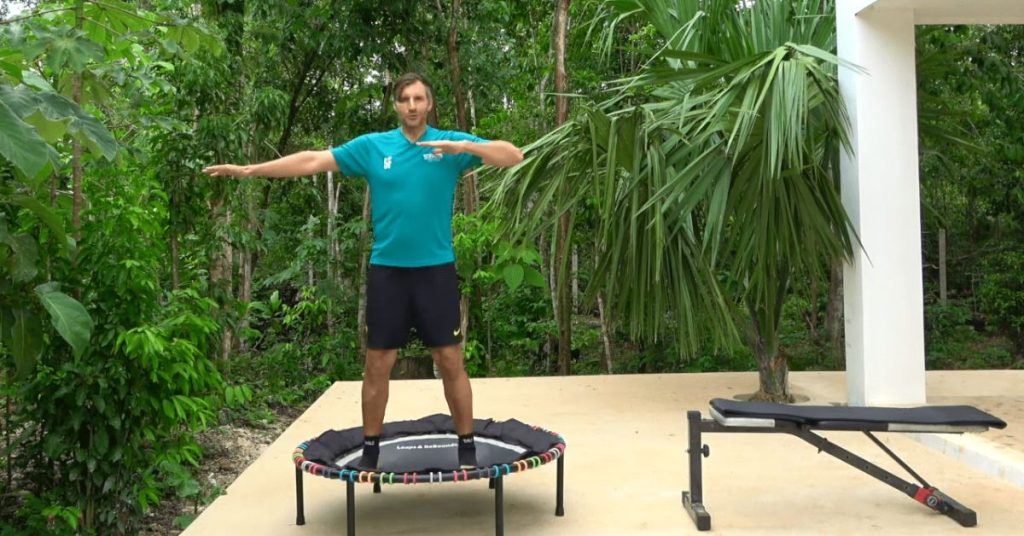
When we think of yoga, we usually imagine taking slow, deep breaths, doing gentle stretches, and flowing movements on a mat on the floor. But have you ever considered doing yoga on a trampoline?
Believe it or not, your trampoline’s flexible mat is a wonderful surface for practicing yoga! Not only is it easy on your joints, but the mat also provides a soft and supportive foundation for stretching and exercising.
Adding yoga to your trampoline workout routine can be a great idea! You can try out our beginner-friendly yoga sequence, designed to calm your mind, warm up your muscles, and improve your flexibility. The best part is, you can do it all from the comfort of your home.
Child’s Pose:
Take a moment to focus on your breath as you bounce on your trampoline. Then, roll onto your stomach and bring your knees in towards your chest. Stretch your arms straight out above your head and allow them to relax and naturally fall.
Rest your forehead on the trampoline mat and close your eyes. Stay in this position for a couple of minutes, taking deep breaths. This pose helps you relax and unwind while enjoying the gentle bounce of the trampoline.
Relaxation Pose:
To start your trampoline yoga routine, begin with Savasana, also known as the corpse or resting pose. Lie down on your back in the center of the trampoline mat. Keep your arms relaxed by your sides, with your fingers and toes naturally curling.
Close your eyes and start taking slow, deep breaths through your nose. You can stay in this position for as long as you’d like. There’s no specific time limit. The goal is to feel calm and serene by the time you finish while maintaining your deep breathing.
Downward Facing Dog Pose:
From the cat pose, transition into the Downward Dog pose. This pose involves stepping both feet back behind you and extending them straight on the trampoline. Extend your arms forward, placing your palms flat on the trampoline mat.
Your body should form an upside-down V shape, with your bottom lifted high in the air and your legs balanced on your toes. Take deep breaths as you stretch and gently pull your heels toward the mat. This pose helps to stretch your entire body and promotes balance and strength.
Cat Stretch Pose:
From the child pose, place your hands on the trampoline mat next to your body and push yourself up. Your body should resemble a table, with your knees and hands supporting your straight torso. Remember to keep breathing deeply throughout the pose.
To avoid straining your neck, keep your head in a comfortable position without tilting it too far forward or backward. Hold this position for about a minute or as long as feels comfortable.
This pose helps to stretch your back, arms, and legs while providing a stable and supportive base on the trampoline. Enjoy the sensation and benefits of this pose while maintaining a steady breath.
Forward Fold Pose:
Bring your feet close together and slowly lift your hands off the trampoline mat. Now, you should be standing on both feet, with your upper body curled inward toward your knees.
Bring your arms in, gently holding the opposite elbow with your hands, and take deep breaths as you feel the stretch. This pose helps to release tension in your back and shoulders while promoting relaxation. Enjoy the stretch and focus on your breathing.
Extended Side Angle Pose:
After holding the rag doll pose for a minute on the trampoline, slowly release your arms and roll back up to a straight standing position. Take a couple of deep breaths, and then raise your arms above your head, bringing your hands together in a pointed position.
As you exhale, gently bend your upper body to one side, creating an arc shape. Hold this stretch for a minute, then return to your standing position and repeat on the opposite side.
This exercise helps to stretch your side body and improve flexibility. Remember to breathe deeply and enjoy the movement.
Elevate Your Pilates Practice with Trampoline Pilates
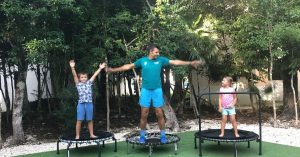
More than 11 million people around the world practice Pilates. These individuals are dedicated to improving their flexibility, strength, balance, and body awareness.
However, have you ever wondered how many of these 11 million people incorporate Pilates into their trampoline workouts?
They should because the benefits of Pilates align perfectly with the effects of bouncing on a trampoline. It’s a perfect combination! Pilates is specifically designed to tone, lengthen, and strengthen muscles. It provides a low-impact workout that is effective in reducing body fat.
After you finish your trampoline exercises, give our Pilates workout a try. It will further enhance your fitness routine and help you achieve your goals.
Hundred Repetitions:
Activate your body and engage your abdominal muscles with this popular Pilates exercise!
Begin by lying on your back. Straighten your legs and point your toes, then lift both legs slightly off the ground to activate your core. Sit up halfway into a crunch position and extend both arms straight in front of you, palms facing down.
Pump your arms energetically up and down, repeating the movement 100 times while maintaining your position. If needed, take a short break to rest. This exercise will increase your heart rate, work your abdominal muscles, and leave you feeling energized.
Kickbacks Like a Donkey:
Start by getting on your hands and knees in the center of the trampoline. Raise your right leg straight up behind you, making sure to keep your body stable and still.
Gently lower your leg back down, stopping just before it touches the trampoline. Repeat this movement for the desired number of repetitions. This exercise targets your leg muscles and helps improve stability and balance. Take it at your own pace and enjoy the benefits of this movement.
Circular Leg Movements:
Begin by lying down on your back in the center of the trampoline. Lift one leg straight up towards the sky, with your toes pointing upward. Start making circular motions with your leg, starting with small circles and gradually increasing their size.
Keep up the circling motion for one minute, maintaining a moderate speed. Then, lower your leg back down. Repeat this exercise for three sets of one minute each, alternating legs.
This exercise targets your leg muscles and helps improve flexibility and coordination. Take your time and enjoy the movement on the trampoline.
Rolling Ball Exercise:
Sit in the middle of the trampoline with your knees tucked into your chest. Point your toes and hold the front of your ankles with your hands. Slowly roll backward, rounding your spine to create a ball shape with your body.
Using your core muscles, push yourself back up into a sitting position. Repeat this exercise for three sets of ten repetitions each. This exercise targets your core muscles and helps improve your balance and stability. Take your time and enjoy the movement on the trampoline.
Tips for Trampoline Workout Success
Trampoline exercises for adults can help with weight loss, improve endurance, and reduce the risk of lifestyle-related diseases like diabetes and obesity. Here are some important tips to keep in mind:
- Stay hydrated: Have a water bottle nearby and drink water regularly during your trampoline workout.
- Start at your level: Begin with a manageable duration, like a 20-minute workout for beginners, and gradually increase the intensity and duration as you become more fit.
- Take breaks: Allow yourself sufficient rest periods between exercise sets to recover and avoid overexertion.
- Warm-up and cool down: Begin and end your workout with gentle bouncing sets to warm up your muscles and cool down your body.
- Protect yourself from the sun: Wear a hat and apply sunscreen to shield yourself from harmful UV rays while exercising outdoors.
- Enjoy yourself: The most important tip of all is to have fun! Trampoline workouts can be enjoyable and rewarding, so make the most of it.
By following these tips, you can make the most out of your trampoline workout and achieve your fitness goals.
Additional Advantages of Working Out on a Trampoline
For many years, using a trampoline for exercise and weight management has been recognized as highly effective. It not only helps increase strength, improve health, and enhance flexibility but there is also research suggesting that regular trampoline use can make individuals appear and feel younger.
Initially, this claim might seem unbelievable. You might wonder how exactly bouncing on a trampoline can have such a remarkable effect on one’s appearance.
The explanation, however, is straightforward and interconnected. Here are a few reasons why trampolines can help you look and feel years younger.
Advanced Trampoline Exercises
Here are the advanced trampoline exercises:
Backflip:
The backflip is an advanced trampoline exercise where you perform a complete backward rotation in the air. To execute a backflip, you need a combination of coordination, strength, and technique.
Start by bending your knees and jumping high into the air. As you reach the peak of your jump, tuck your knees towards your chest and initiate the backward rotation. Use your core muscles and arm movements to generate the necessary momentum.
Extend your legs outwards and spot the trampoline as you approach the landing. Maintain control throughout the rotation and land safely on the trampoline.
Front flip:

Similar to the backflip, the front flip involves rotating forward in the air while jumping on the trampoline. It requires core stability, control, and proper body positioning. Begin by bending your knees and jumping upward.
As you reach the highest point of your jump, tuck your knees towards your chest and initiate the forward rotation. Extend your legs outwards, spot the trampoline, and prepare for landing. Maintain control throughout the flip and ensure a safe landing.
360-degree twist jump:
The 360-degree twist jump combines a full 360-degree twist with a jump on the trampoline. Start by jumping high into the air and initiate the twist by using your core muscles and arm movements.
Rotate your body horizontally in a complete 360-degree spin. Spot the trampoline as you approach the landing and prepare to absorb the impact with your knees.
This exercise challenges your coordination, balance, and spatial awareness as you perform the twist while in mid-air.
Double bounce combinations:
Double bounce combinations involve executing various jumps and bounce using the double bounce technique. The double bounce is achieved by coordinating your bounce with the rebound from another person or by utilizing the elasticity of the trampoline.
With precise timing and control, you can perform multiple jumps with fluid transitions. You can incorporate different jumps such as tuck jumps, pike jumps, or straddle jumps, and combine them in creative sequences to challenge your skills and coordination.
It is crucial to note that advanced trampoline exercises should only be attempted by experienced individuals who have developed proper skills and techniques. Safety should be the top priority, and it is recommended to receive proper instruction or supervision when performing these moves.
Trampoline exercises for strength and conditioning
Trampoline exercises can be a fun and effective way to improve strength and conditioning. Here are some exercises that target different muscle groups and help enhance overall fitness:
Squat Jumps:
Squat jumps are an excellent trampoline exercise for building lower body strength and explosive power. Begin by standing with your feet shoulder-width apart. Lower down into a squat position, keeping your knees in line with your toes and your chest lifted.
From the squat, explode upwards into a jump, reaching as high as you can. Land softly back into the squat position and repeat the movement. This exercise targets your quadriceps, hamstrings, glutes, and calf muscles, providing a challenging workout for your lower body.
Push-Up Variations:
Push-ups are a classic exercise for building upper body strength, and performing them on a trampoline adds an extra challenge. Start in a plank position with your hands resting on the trampoline mat.
Lower your chest towards the mat, keeping your elbows close to your body, and then push back up to the starting position.
You can vary the difficulty by trying different push-up variations, such as wide push-ups, diamond push-ups, or staggered push-ups. These exercises primarily target your chest, shoulders, triceps, and core muscles.
Mountain Climbers:
Mountain climbers are a challenging full-body exercise that targets multiple muscle groups. Start in a plank position with your hands resting on the trampoline mat. Bring one knee towards your chest, then quickly switch and bring the other knee forward while extending the opposite leg back.
Continue alternating your legs in a running motion, keeping your core engaged and maintaining a steady pace. Mountain climbers work your core, shoulders, arms, and leg muscles, providing a great cardiovascular and strength-building workout.
Remember to warm up before engaging in any exercise routine and listen to your body. If you are new to these exercises or have any health concerns, it’s advisable to consult with a fitness professional before attempting them.
Trampoline exercises for core stability

Below, are several trampoline exercises for core stability:
Pike Jumps:
Start by standing on the trampoline with your feet hip-width apart. Bend your knees slightly and jump up, lifting your legs straight in front of you as high as you can.
At the same time, reach your hands towards your toes, trying to touch them. Keep your core muscles engaged throughout the movement.
Land softly on the trampoline and repeat the exercise for a set number of repetitions. Pike jumps help strengthen your abdominal muscles, including the rectus abdominis and the muscles in your lower back.
Side Plank Rotations:
Begin by lying on your side on the trampoline, supporting your body weight on one forearm with your elbow directly below your shoulder. Extend your legs, stacking one on top of the other. Lift your hips off the trampoline, creating a straight line from your head to your feet.
Engage your core and rotate your torso, reaching your free arm towards the ceiling. Return to the starting position and repeat the movement. Side plank rotations target the oblique muscles and improve core stability and strength.
Russian Twists:
Sit on the trampoline with your knees bent and your feet slightly off the ground. Lean back slightly, maintaining a straight back. Extend your arms in front of you and clasp your hands together.
Twist your torso to one side, bringing your hands towards the ground beside your hip. Keep your core engaged and control the movement.
Return to the starting position and then twist to the opposite side. Russian twists work the obliques and help improve rotational stability in the core.
V-Sit Bounces:
Sit on the trampoline with your knees bent and your feet flat on the mat. Lean back slightly, engaging your core. Lift your feet off the ground and extend your legs in a V-shape, forming a “V” position with your body.
Maintain balance and stability as you bounce up and down in the V-sit position. This exercise targets the entire core, including the abdominal muscles and hip flexors, while also improving balance and coordination.
Bicycle Kicks:
Lie on your back on the trampoline with your legs extended. Place your hands lightly behind your head, elbows pointing out to the sides. Lift your head, neck, and shoulders off the trampoline and engage your core.
Bend one knee and bring it towards your chest while simultaneously twisting your upper body to bring your opposite elbow towards the bent knee. Straighten the bent leg and repeat the movement on the other side, alternating in a pedaling motion.
Bicycle kicks engage your entire core, including the rectus abdominis, obliques, and hip flexors, while also improving coordination and flexibility.
Leg Drops:
Lie on your back on the trampoline with your legs extended towards the ceiling. Place your hands by your sides or underneath your hips for support. Engage your core and lower both legs towards the mat, keeping them straight.
Go as low as you can while maintaining control and without arching your back. Lift your legs back up to the starting position and repeat the movement.
Leg drops target your lower abdominal muscles and hip flexors, helping to strengthen and stabilize your core.
Remember to always maintain proper form and start with exercises that match your fitness level. Gradually increase the intensity and duration of your trampoline workouts as you build strength and stability in your core muscles.
Cooling down and stretching exercises
Cooling down and stretching exercises are an important part of any workout routine, including trampoline exercises. They help promote muscle recovery, prevent injury, and increase flexibility. Here are some cooling down and stretching exercises you can perform:
Gentle Bouncing:
After your trampoline workout, spend a few minutes engaging in light bouncing. This helps gradually lower your heart rate and allows your body to transition from a high-intensity workout to a resting state. Keep the bouncing gentle and relaxed.
Leg Swings:
Stand next to the trampoline, holding onto a stable object for support. Swing one leg forward and backward in a controlled manner, keeping it straight. This exercise helps stretch and loosen the muscles in your legs. Perform 10-15 swings on each leg.
Shoulder Rolls:
Stand tall with your feet shoulder-width apart. Roll your shoulders forward in a circular motion, then backward. This exercise helps release tension in the shoulders and improves flexibility. Perform 10-15 rolls in each direction.
Hamstring Stretches:
Sit on the trampoline with one leg extended straight in front of you and the other leg bent. Reach forward with both hands and gently lean forward, aiming to touch your toes. Feel the stretch in the back of your thigh (hamstring). Hold the stretch for 20-30 seconds on each leg.
Remember to breathe deeply during each stretch and never push yourself beyond your comfort level. Stretching should be done in a controlled and relaxed manner.
These cooling down and stretching exercises will help your body gradually return to a resting state and optimize your recovery.
Trampoline Safety Precautions
Here are some trampoline safety precautions:
- Choose a high-quality trampoline in good condition.
- Set up the trampoline on a level surface with adequate space around it.
- Use safety pads to cover the springs and frame.
- One person at a time on the trampoline to avoid collisions.
- No somersaults or dangerous stunts, especially for beginners.
- Regularly inspect the trampoline for wear and tear.
- Supervise children at all times during trampoline use.
- Avoid bouncing too high to reduce the risk of injuries.
- Place the trampoline away from trees or other hazards.
- Educate users about safe jumping techniques and potential risks.
FAQs:
Q:1 Is trampoline jumping an effective workout?
Jumping on a trampoline can be a great workout that helps improve your fitness level. It’s a fun and low-impact exercise that can strengthen your muscles, improve your heart health, and enhance your balance and stability.
It’s a good way to add variety to your exercise routine and enjoy a different form of physical activity.
Q:2 Which exercises are recommended for trampoline workouts?
The best exercises to do on a trampoline include straight jumps, star jumps, swivel hips, tuck jumps, seat drops, pike jumps, jumping jacks, and straddle jumps.
These exercises involve different movements and jumps that can help you improve your fitness and have fun on the trampoline.
Q:3 Can jumping on a trampoline help reduce belly fat?
Jumping on a trampoline is a great full-body workout. The force created by bouncing helps build muscle and burn fat effectively. It tones and strengthens various areas of your body, such as your legs, thighs, arms, hips, and stomach.
Q:4 What is the equivalent of 10 minutes of trampoline exercise?
Just 10 minutes of jumping on a trampoline is as beneficial as a 30-minute run. This means that trampoline exercise is a time-efficient option, especially for busy parents who find it challenging to fit in exercise.
You can simply have a quick jump session in your backyard and enjoy the same benefits in the longer run.
Q:5 How many minutes of trampoline jumping equal a mile of distance covered?
As per Leaps and Rebounds, jumping on a trampoline for five minutes is similar to taking a one-mile walk. In simpler terms, the energy and effort exerted during a short trampoline session can provide similar benefits to walking a mile.
Conclusion:
In conclusion, trampoline exercises offer a wide range of benefits for individuals seeking a fun and effective workout. From improving cardiovascular fitness and building strength to enhancing balance and coordination, trampolining engages the whole body while minimizing the impact on joints.
Some of the best trampoline exercises include straight jumps, star jumps, swivel hips, tuck jumps, seat drops, pike jumps, jumping jacks, and straddle jumps. These exercises target various muscle groups, promote flexibility, and improve overall fitness levels.
Additionally, research suggests that trampoline workouts can burn calories, build muscle, and aid in weight loss. The high-intensity nature of trampolining can increase metabolism and promote fat burning.
It’s important to note that safety should always be a priority when engaging in trampoline exercises. Proper technique, adequate warm-up and cool-down, and supervision for beginners are essential.
Incorporating trampoline exercises into your fitness routine can add excitement and variety while reaping the numerous physical benefits. So, grab a trampoline and bounce your way to a healthier, stronger, and more enjoyable workout experience!
We hope you will be well aware of the best trampoline exercises, after reading this comprehensive article. If you have any questions, feel free to comment below!

